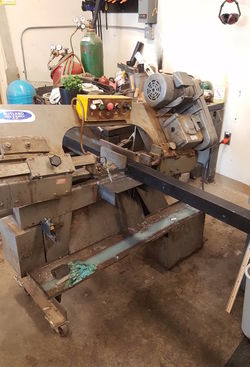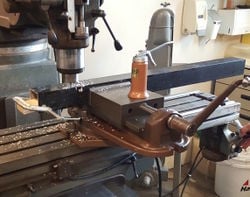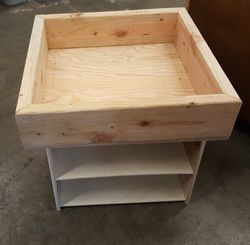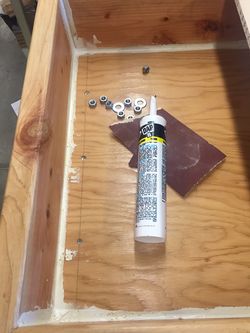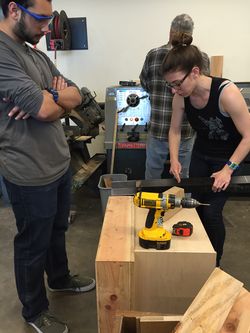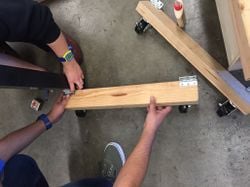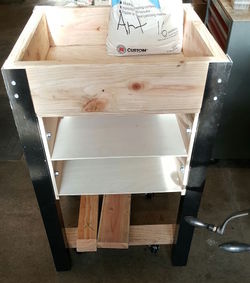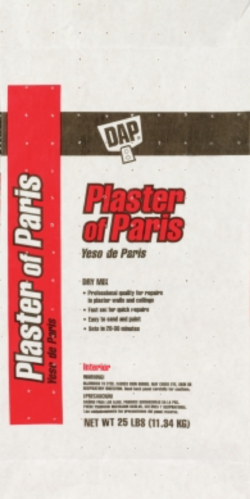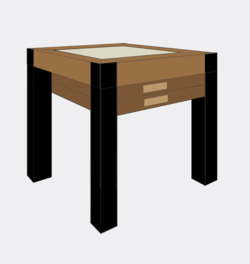| Line 96: | Line 96: | ||
==Testing Results== | ==Testing Results== | ||
The original design that was chosen was modified along the way to improve any of the obstacles that were encountered. Some of the things that were adjusted were the replacement of shelves instead of drawers. An implementation of a latch on the caster mechanism improved its portability capability. | |||
==How to build== | ==How to build== | ||
Revision as of 00:30, 2 May 2016
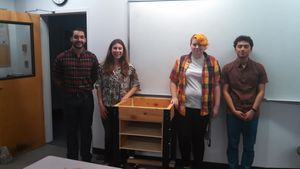
Abstract
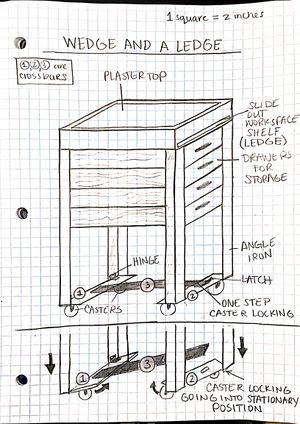
The purpose of this project is to create a wedging table that will be used in Zane Middle School’s Art class. The Imagineers team created and designed a wedging table to provide a reliable efficient area to wedge clay. The Imagineers was formed as part of Humboldt State University’s Engineering 215: Introduction to Design, taught by Camille Penny.
Background
Humboldt State University's Engineering 215: Introduction to Design provides its class with experience in design projects, team building, and communication skills. The Imagineers team was formed as part of an assignment for Engineering 215. The team's task was to provide Zane Middle School with a wedging table for their Art class. The team members include Oscar Bermudez, Shaela Hogue, Vincent Hurtado, and Erin Pyne.
Problem Statement
The objective of this project was to provide Zane Middle School with a portable area to wedge clay. The Imagineers designed a wedging table that can be portable and is also able to be stationary when in use, the table also provides storage and a side ledge to place dry clay.
Criteria
Below is a table listing and defining the criteria that was considered when choosing the projects' final design.
| Criterion | Definitions |
|---|---|
| Safety | The table should not contain any toxic chemicals, sharp metal, or splintered wood. The locking casters need a caution warning. |
| Sturdiness | The table should not be able to teeter over, wood or metal must be securely attached throughout the table, and the locking casters must be able to remain locked. |
| Portability | The table should move with ease, fit within all doorways, and be able to lock in place. |
| Durability/Longevity | the table should need little maintenance, and should be able to withstand minor weathering. |
| Cost | The cost for materials that compose the wedge and a ledge cannot exceed the amount of $300; this includes $75 per group member. |
| Environmental Impact/Sustainability | Reusable items would be most preferred, or the use of less harmful products used to construct the design. |
| Aesthetics | The table needs to be appealing to the public eye. It should be clean and not look out of place. |
Description of final project

Through the use of the Delphi Method, this is a process where as a team we evaluated each one of the designs each of the team members created, the design with the greatest raking would be chosen as the final design. The solution with the greatest ranking was “Wedge and a Ledge” design. This design is located to the right, it meets most of the criteria that was stated above section "Criteria". It is appealing, affordable, made of durable materials, uses materials with low impact to the environment, highly portable, is one of the safer alternatives, and is reinforced with three crossbars which provide it with support.
Costs

Below and is a table showing the cost of the materials used along with the grand total (the total does not include the value of materials that were donated). Figure 4 shows the amount of hours spent in each phase of the design project along with the total amount of hours.
| Quantity | Material | Source | Cost ($) | Total ($) |
|---|---|---|---|---|
| 2 | Aluminum posts | Arcata Scrap | 7.50 | 15.00 |
| 4 | Casters | Ace Hardware | 7.99 | 31.96 |
| 4 | Hinges | Ace Hardware | 5.39 | 21.56 |
| 1 | Micellaneous Hardware & etc. | Ace Hardware | NA | 32.76 |
| 16 | Screws for Casters | Ace Hardware | .22 | 3.52 |
| 16 | Screws for plaster box | Ace Hardware | NA | NA |
| 2 boards, 2 sheets of plywood | Wood | Donated by Almquist Lumber | NA | NA |
| 1 | Wood glue | Donated by Almquist Lumber | NA | NA |
| 3 | Plaster of paris | Client | 21.00 | 63.00 |
| Total Cost | $168 | |||
Testing Results
The original design that was chosen was modified along the way to improve any of the obstacles that were encountered. Some of the things that were adjusted were the replacement of shelves instead of drawers. An implementation of a latch on the caster mechanism improved its portability capability.
How to build
Next Steps
The “Wedge and a Ledge” design will be placed in the art room storage area while it is not in use. The table will remain stationary while the caster locking mechanism is disengaged. When the table needs to be used, the mechanism must be engaged for the table to be rolled to the designated wedging area. Once in that area, the mechanism can be disengaged so that the table remains stationary during use.
Results
As of Monday, May 2nd 2016, the “Wedge and a Ledge” design was completed and is ready for use by the Ken Weiderman and his students. We successfully demonstrated our constructed design to judges, our peers, and our instructor during a presentation to Zane Middle School.
References
- Bayer, M. F. (1922). “Caster Lock.” United States Patent Office, US1428932 A.
- Bergeson, Lynn L. (2014). “FTC’s Recent Enforcement Cases for Misleading Recycled Content Claims.” Regulatory Developments, <http://www.acta group.com/regulatory-developments/entry/ftcs-recent-enforcement-cases-for-misleading-recycled-content-claims> (Feb. 20, 2016)
- Boesel, J., Richey, J (1993). Machines on Wheels, The Taunton Press, Newtown, Connecticut. Caster City. (2016). “Dual Wheel Casters- Total Locking Brake.” <http://www.castercity.com/specific-app-casters/dual-wheelcasters.htm> (Feb. 23, 2016)
- Ceramic Arts Community (2014) “Wedging Table Surface Options – Studio Operations and Making Work." Ceramic Arts Daily Community <http://community.ceramicartsdaily.org/topic/5460- wedging-table-surface-options/> (Feb. 2016).
- Ed. Koichi Hirata. (2002). "Metal Materials." Elementary Knowledge of Metalworking, <https://www.nmri.go.jp/eng/khirata/metalwork/basic/material/index_e.html> (Feb. 25, 2016).
- Frisch, David, and Susan Frisch, (1998). Metal: Design and Fabrications. N.p.: Whitney Library of Design. Print.
- Gumpert, Meagan C. (2014.) "Clay Wedging Table - Plaster Mixing Ratios and Guidelines." Clay and Glass Blog of Meagan Chaney Gumpert, <http://www.meaganchaneygumpert.com/> (Feb. 20, 2016)
- Hutchings, Gilbert R., G. Eugene. Martin, and J. Mario Coleman. 1982. Working with Wood. Bloomington IL: McKnight Pub., Print
- Meier, Eric. (2008). “The Wood Database.” The Wood Database, <http://ww w.wood-database.com/> (Feb. 24, 2016).
- Mike. (2014). "Painting furniture – Should I use latex or oil paint? <http://lauerfurniture.com/painting-furniture-should-i-use-latex-or-oil- paint/> (Feb. 23, 2016)
- Miodownik, Mark. (2013). Stuff Matters. Houghton Mifflin Harcourt Publishing Company. New York, NY.
- Rockler. (2007). “Wood Stain in a Nutshell” Buzzsaw Blog, <http://www.rockler.com/how-to/wood-stain-in-a-nutshell> (Feb. 24, 2016)
- Walters, C. (1935). “Tools And Materials: Via: Ceramic Sculpture; The Preparation Of The Clay”. The American Magazine of Art, 28(8), 500–502.
- Walstrom, Emil A., (1942). "Builder's Safety Horse Clamp." United States Patent Office, <https://www.google.com/patents/US2330766> (Feb. 25, 2016).
